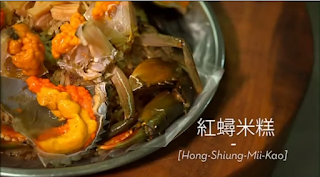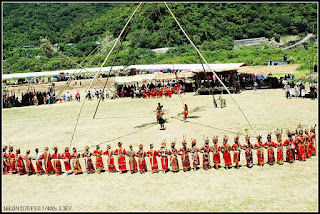Explore real adventures, real people, real Taiwan
info@friendsintaiwan.net | FriendsInTaiwan.net
Wednesday, July 29, 2015
Saturday, July 25, 2015
The Tour of Messes, a French Documentary about Food in Taiwan
 |
| Crab Rice. Photo : La tournée des popotes |
The host, chief professor Chien-Hao, showed his French guest Gregory some authentic and refined Taiwanese food on the streets and in the restaurants.
Introduced in this film were some of the signature food such as Ding Tai Feng Dumplings, traditional breakfast, Stinky Tofu, Oyster Omelet, Boba MilkTea, Tofu Pudding and Crab Rice. The film only scratched the surface of our food culture. But it is pretty entertaining and enlightening. It is a film that foodies would not want to miss; a film that you would not want to watch when hungry.
Tuesday, July 21, 2015
Thursday, July 16, 2015
Monday, July 6, 2015
Surf’s Up – Threesome Typhoon Surf Forecast
Hotelcombined
Booking.com
Agoda
________________________________________________________________________________________
Friends in Taiwan
info@friendsintaiwan.net | FriendsInTaiwan.net
Sunday, July 5, 2015
The Adventurers’ Guide to Taiwan in the Summer: Typhoon Surf, River Sports and Tribe Carnival
Despite the
tropical burning sun and spotty thunderstorms, Taiwan has a lot to offer in the
summer time. From July to September, we recommend some highlights, legal or illegal, for all the adventurers.
Summer is
the typhoon season in Taiwan. A typhoon is a mature tropical cyclone that develops in the northwestern part of the
Pacific Ocean. Like hurricanes, typhoons bring the violent winds, incredible
waves, torrential rains, and floods.
In Taiwan, typhoons can cause severe and deadly damages such as floods and mud slides. But depends on the direction and timing, sometimes typhoons also bring some solid swells for advanced surfers. A good window is typically right before and after a typhoon.
As fun as it
may sound, typhoon surfing in Taiwan has a surprising, potential hazard… cops
and fines. Due to the high risk and the limited emergency rescue resources,
typhoon surfing is actually banned in Taiwan.
Although it is a debatable policy, we urge all typhoon surfers to know your limits. Before you paddle out, estimate the risk of high surf, strong currents, and… possible fines. Please feel free to contact us for questions or surf tour services.
Anyways, still can’t make your mind? Consider the following LEGAL adventures in Taiwan…
White Water Rafting, Kayaking or Canyoning:
Summer is
also a thunderstorm season in Taiwan. The abundant rainfall from the thunderstorms
and typhoons make river sports exciting and popular summer activities.
Due to the short distance from the mountain to the sea, experienced rafters or kayakers can find many advanced rapids among the gorges. Advanced tours are also available. Check out an awesome kayaking video here.
People with little or no experiences can join an easier rafting tour and still have fun in level 1 and 2 rapids. Taiwan hosts the world’s one and only triathlon with rafting, running, and cycling every summer. It is a fun race. If you are visiting Taiwan in May, be sure to check out this event.
Taiwan’s
summer fun cannot be completed without the tribe carnival. The tribe carnival
is an authentic, compelling, yet lesser known adventure to the foreigners. As
mentioned in the other post,
Taiwan’s East coast is the homeland of the indigenous people. Nine officially
recognized tribes live in the villages scattered along the coast and in the
high mountains.
Every tribe has its own traditions. But
generally speaking, a harvest ritual consists of traditional ceremonies that
may or may not be open to the public and a block party style of celebration that
is usually open to the visitors.
The “block party” features plentiful homemade millet wine, local food and traditional entertainments, such as singing, dancing and fun contests. Visitors are welcome to join the party with inexpensive “tickets” that usually cover the food and wine or donations. You can also hire an aboriginal tribe tour guide to learn more about their tribes, traditions and behind-the-scenes stories.
Besides the 150+ marathon “block parties”
carnival, local governments also organize a few large-scale Joint Harvest
Rituals of 40 villages. These joint harvest rituals are held in local
parks or on the streets. They may include parades. They are open to the public for free.
Find the best hotel deals below
Hotelcombined
Booking.com
Agoda
________________________________________________________________________________________
Friends in Taiwan
info@friendsintaiwan.net | FriendsInTaiwan.net
Typhoon Surf:
 |
| A typhoon can cause severe floods.. Source: Daily Mail |
In Taiwan, typhoons can cause severe and deadly damages such as floods and mud slides. But depends on the direction and timing, sometimes typhoons also bring some solid swells for advanced surfers. A good window is typically right before and after a typhoon.
A good way
to track typhoons in Taiwan is to read the typhoon charts from Taiwan’s central
weather bureau and the surf hurricane charts of the
Northwest Pacific Ocean from Magic Seaweed or Surfline. When you see the orange’s and
red’s coming, you know it’s happening.
 |
| A typhoon can also produce good waves.. Source: Surfline blog |
Although it is a debatable policy, we urge all typhoon surfers to know your limits. Before you paddle out, estimate the risk of high surf, strong currents, and… possible fines. Please feel free to contact us for questions or surf tour services.
These
typhoon surfing videos may help you assess the risk of typhoon surfing in
Taiwan.
It was firing right before a typhoon hit: If the embedded video is not playing correctly, click the link to see it on Youtube.
It was firing right before a typhoon hit: If the embedded video is not playing correctly, click the link to see it on Youtube.
Anyways, still can’t make your mind? Consider the following LEGAL adventures in Taiwan…
White Water Rafting, Kayaking or Canyoning:
 |
| Taiwan summer adventure: Kayaking. Source: Youtube |
Due to the short distance from the mountain to the sea, experienced rafters or kayakers can find many advanced rapids among the gorges. Advanced tours are also available. Check out an awesome kayaking video here.
People with little or no experiences can join an easier rafting tour and still have fun in level 1 and 2 rapids. Taiwan hosts the world’s one and only triathlon with rafting, running, and cycling every summer. It is a fun race. If you are visiting Taiwan in May, be sure to check out this event.
Easier
canyoning can be done in the summer if the river is not over flooded. Yet the
best time for canyoning is probably in the fall. We will have another post talking about canyoning later.
 |
| Taiwan Indigenous Harvest Rituals: Lukai Tribe. Source: Bao's Blog |
Among them,
five tribes live by the coast. Every summer, from July to September, these
coastal tribes, 150 + villages or 7500+ indigenous villagers, take turns to host
their annual harvest rituals in their villages. As the most important ritual of
the entire year, it is to celebrate the harvest of corps. Originally, the
harvest rituals were held to celebrate the harvest of millet and to show
respect to the ancestors. Now most indigenous people have changed to grow rice.
Therefore, harvest rituals start when rice is ripe for reaping.
 |
| If lucky, you could be invited to the ceremony... ^^ Source: blogger passat911 |
The “block party” features plentiful homemade millet wine, local food and traditional entertainments, such as singing, dancing and fun contests. Visitors are welcome to join the party with inexpensive “tickets” that usually cover the food and wine or donations. You can also hire an aboriginal tribe tour guide to learn more about their tribes, traditions and behind-the-scenes stories.
 |
| Taiwan Indigenous Joint Harvest Rituals. Source; Apple Daily |
Please keep
in mind that except the join harvest rituals hosted by the local governments, all rituals are hosted by
the indigenous people in their home villages. Mutual respect and party guest
etiquette are expected when visiting tribes. We will share some rules of
manners in our next post. Please contact us for help in arrangements.
Hotelcombined
Booking.com
Agoda
________________________________________________________________________________________
Friends in Taiwan
info@friendsintaiwan.net | FriendsInTaiwan.net
Subscribe to:
Comments (Atom)
Booking a hotel? |



